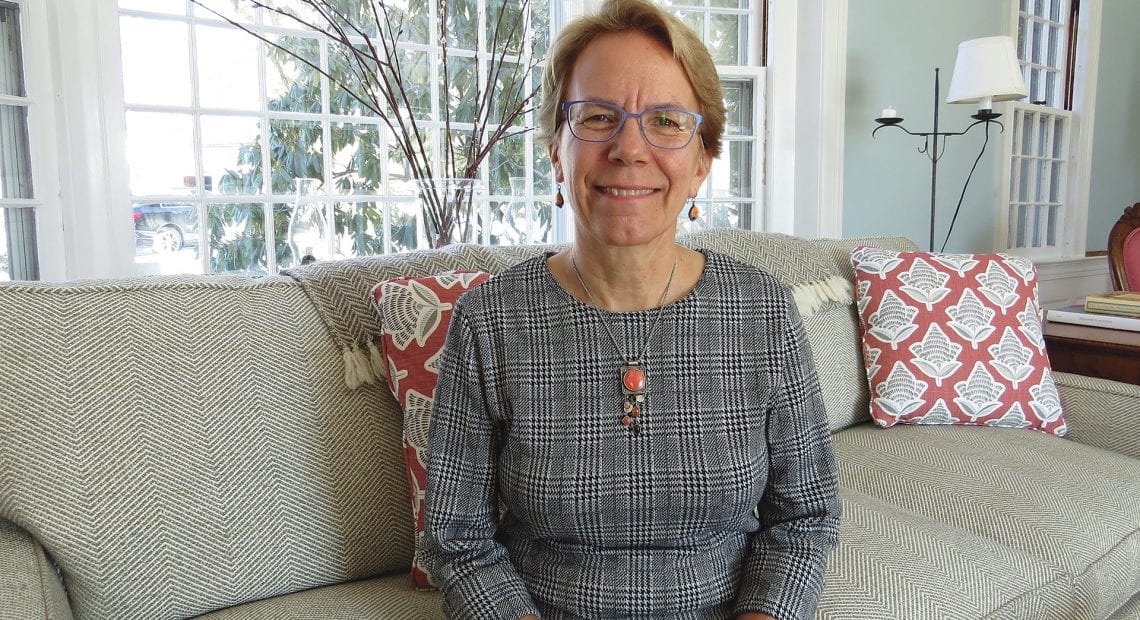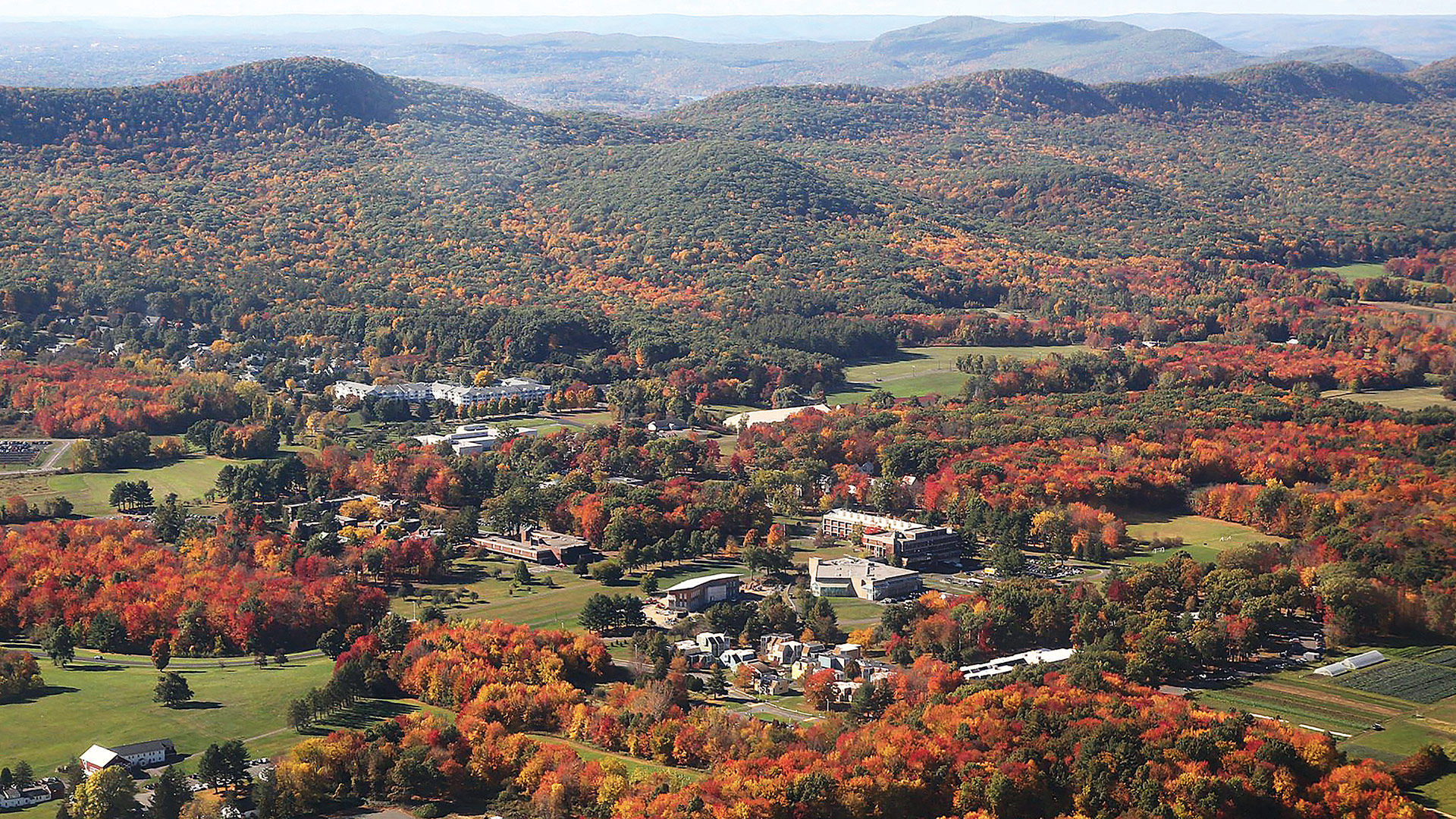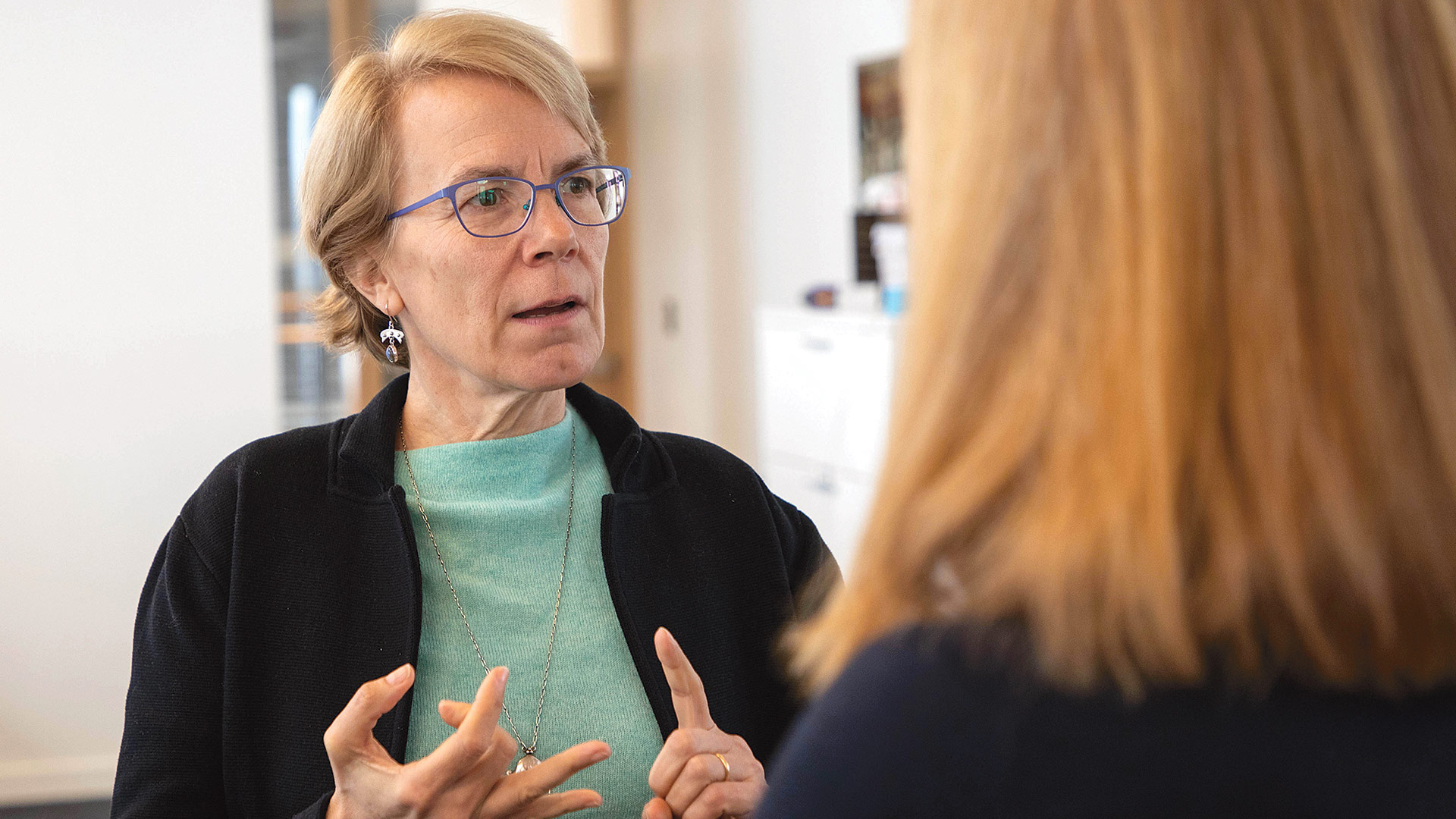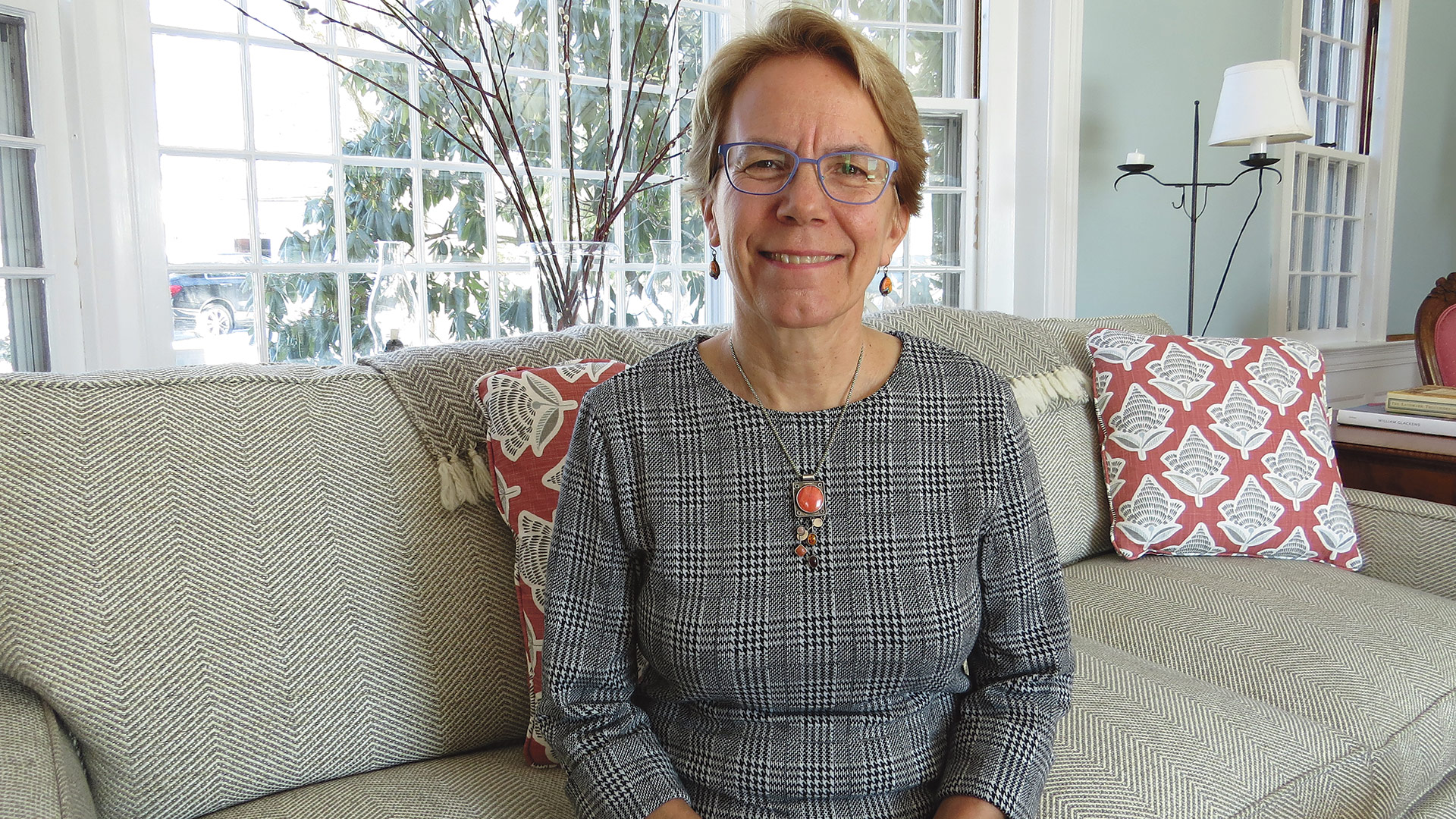
Hampshire College Brings Challenges in Higher Ed into Sharper Focus
The Face of a Changing Landscape
As high-school graduating classes continue to get smaller and the competition for those intensifies, many smaller independent colleges are finding themselves fighting for their very survival. One of them is Hampshire College in Amherst, which, because of its unique mission, alternative style, and famous alums (including Ken Burns), has in many ways become the face of a growing crisis.
Miriam Nelson says she became a candidate to become the seventh president of Hampshire College — and accepted the job when it was offered to her last April — with her eyes wide open, fully aware of the challenges facing that Amherst-based institution and others like it — not that there are many quite like Hampshire.
Then she clarified those comments a little. She said she knew the school was struggling with enrollment and therefore facing financial challenges — again, as many smaller independent schools were and still are. But she didn’t know just how bad things were going to get — and how soon.
She became aware through a phone call on May 2 from the man she would succeed as president of the school, Jonathan Lash.
“He let me know that our target number for enrollment this year was significantly lower than what was expected; I think he knew, and I knew, at that time that my job this year was going to be different than what I’d planned,” she recalled, with a discernable amount of understatement in her voice.
Indeed, with that phone call — and the ensuing fight for its very survival — Hampshire became, in many ways, the face of a changing landscape in higher education, at least in the Northeast.
That’s partly because of the school’s unique mission, alternative style, and notable alums such as documentary filmmaker Ken Burns. But also because of heavy media coverage — the New York Times visited the campus earlier this month, one of many outlets to make the trip to South Amherst — and the fact that the school is really the first to carry on such a fight in an open, transparent way.
In some ways, Hampshire is unique; again, it has a high profile, and it has had some national and even international news-making controversies in recent years, including a decision by school leaders to take down the American flag on campus shortly after the 2016 election, while students and faculty members at the college discussed and confronted “deeply held beliefs about what the flag represents to the members of our campus community,” a move that led veterans’ groups to protest, some Hampshire students to transfer out, and prospective students to look elsewhere.
But in most respects, Hampshire is typical of the schools now facing an uncertain future, said Barbara Brittingham, president of the New England Commission of Higher Education (NECHE), adding that those fitting the profile are smaller independent schools with high price tags (tuition, room, and board at Hampshire is $65,000), comparatively small endowments, and student bodies made up largely, if not exclusively, of recent high-school graduates.
That’s because high-school graduating classes have been getting smaller over the past several years, and the trend will only continue and even worsen, said Brittingham, citing a number of recent demographic reports.
Meanwhile, all schools are confronting an environment where there is rising concern about student debt and an increased focus on career-oriented degrees, another extreme challenge at Hampshire, where traditional majors do not exist.
“He let me know that our target number for enrollment this year was significantly lower than what was expected; I think he knew, and I knew, at that time that my job this year was going to be different than what I’d planned.”
None of these changes to the landscape came about suddenly or without warning, said Brittingham, noting that the storm clouds could be seen on the horizon years ago. Proactive schools have taken a variety of steps, from a greater emphasis on student success to hiring consultants to help with recruiting and enrollment management.
But for some, including several schools in New England, continued independence and survival in their original state was simply not possible. Some have closed — perhaps the most notable being Mount Ida College in Newton, which shut down abruptly two months before commencement last spring — while others have entered into partnerships, a loose term that can have a number of meanings.
In some cases, it has meant an effective merger, as has been the case with Wheelock College and Boston University and also the Boston Conservatory and the Berklee College of Music, but in others, it was much more of a real-estate acquisition, as it was with Mount Ida, bought by UMass Amherst.
What lies ahead for Hampshire College is not known, and skepticism abounds, especially after the school made the hard decision not to admit a full class for the fall of 2019. But Nelson remains optimistic.

An aerial photo of the Hampshire College campus, which has been in the national media spotlight since it was announced that the school was looking to forge a partnership with another school in order to continue operations.
“Hampshire has always been innovative, and we’re going to do this the ‘Hampshire way,’” she said during an interview in the president’s off-campus residence because her office on the campus was occupied by protesting students. “We’re thinking about our future and making sure that we’re as innovative as we were founded to be. We need to make sure that our financial model matches our educational model.”
For this issue and its focus on education, BusinessWest talked with Nelson and Brittingham about the situation at Hampshire and the changing environment in higher education, and how the school in South Amherst has become the face of an ongoing problem.
New-school Thinking
Those looking for signs indicating just how serious the situation is getting within the higher-education universe saw another one earlier this month when Massachusetts Gov. Charlie Baker filed legislation to strengthen the state’s ability to monitor the financial health of private colleges.
“Our legislation will strengthen this crucial component of our economy, but most importantly, it will help protect students and their families from an abrupt closure that could significantly impact their lives,” Baker said in a statement that was a clear reference to the Mount Ida fiasco.
The bill applies to any college in Massachusetts that “has any known liabilities or risks which may result in imminent closure of the institution or jeopardize the institution’s ability to fulfill its obligations to current and admitted students.”
And that’s a constituency that could get larger in the years and decades to come, said Brittingham, adding that demographic trends, as she noted, certainly do not bode well for small, independent schools populated by recent high-school graduates.
She cited research conducted by Nathan Grawe, author of Demographics and the Demand for Higher Education, which shows that, in the wake of the Great Recession that started roughly 11 years ago, many families made a conscious decision to have fewer children, which means the high-school graduating classes in the middle and end of the next decade will be smaller.
“Things are going to get worse around 2026,” she said. “The decline that is there now will only get more dramatic, especially in New England.”
As noted earlier, Nelson understood the landscape in higher education was changing when she decided to pursue a college presidency, and eventually the one at Hampshire, after a lengthy stint at Tufts and then at the University of New Hampshire as director of its Sustainability Institute.
She told BusinessWest that Hampshire offered the setting — and the challenge — she was looking for.
“Hampshire was the one where I thought there was the most opportunity, and the school that was most aligned with more core values and my interests,” she explained, adding that she was recruited by Lash for the post. “This school has always been inquiry-based, and I always like to start with a question mark. To be at Hampshire means you have to have imagination and you have to be able to handle ambiguity when you have an uncertain future; that’s one of the hallmarks here at Hampshire.”
Imagination is just one of the qualities that will be needed to help secure a solid future for the school, she acknowledged, adding that, while the current situation would be considered an extreme, the college has been operating in challenging fiscal conditions almost from the day it opened in 1970 — and even before that.
“We started out under-resourced, and we’ve had different moments during almost every president’s tenure where there were serious concerns about whether the college could continue,” she said. “We’ve always been lean, but we’ve managed.”
“Things are going to get worse around 2026. The decline that is there now will only get more dramatic, especially in New England.”
However, this relatively thin ice that the college has operated on became even thinner with the changing environment over the past several years, a climate Nelson put in its proper perspective.
“Higher education is witnessing one of the most disruptive times in history, with decreasing demographics, increased competition for lower-priced educational offerings, and families demanding return on investment in a college education in a short period of time,” she told BusinessWest. “There’s a lot of factors involved with this; it is a crisis point.”
A crisis that has forced the college to reach several difficult decisions, ranging from layoffs — several, effective April 19, were announced last month involving employees in the Admissions and Advancement offices — to the size and nature of the incoming class.
Indeed, due to the school’s precarious financial situation — and perhaps in anticipation of the governor’s press for greater safeguards against another Mount Ida-like closing, Hampshire has decided to admit only those students who accepted the school’s offer to enroll via early admission and those who accepted Hampshire’s offer to enroll last year but chose to take a gap year and matriculate in the fall of 2019.
Nelson explained why, again, in her most recent update to the Hampshire community, posted on the school’s website, writing that “our projected deficit is so great as we look out over the next few years, we couldn’t ethically admit a full class because we weren’t confident we could teach them through to graduation. Not only would we leave those students stranded — without the potential for the undergraduate degree they were promised when they accepted Hampshire — we would also be at risk of going on probation with our accreditors.”

Hampshire College is just one of many smaller independent schools challenged by shrinking high-school graduating classes and escalating competition for those students.
While reaching those decisions, leaders at the college have also been working toward a workable solution, a partnership of some kind that will enable the school to maintain its mission and character.
Ongoing work to reach that goal has been rewarding on some levels, but quite difficult on all others because of the very public nature of this exercise, said Nelson, adding that her first eight months on the job have obviously been challenging personally.
She said the campus community never really got to know her before she was essentially forced into crisis management.
And now, the already-tenuous situation has been compounded by negativism, criticism (Nelson has reportedly been threatened with a vote of no confidence from the faculty), and rumors.
“There’s a lot of chaos and false narratives out there,” she explained. “So I’ve been working really hard both in print and in many assemblies and meetings to get accurate information out. This is a world with lots of false narratives and conspiracy theories; we heard another one yesterday — they’re really creative and interesting. I don’t know how people think them up.”
Textbook Case?
As she talked about the ongoing process of finding a partnership and some kind of future for Hampshire College, Nelson said she’s received a number of phone calls offering suggestions, support, and forms of encouragement as she goes about her work in a very public way.
One such call was from a representative of the Mellon Foundation.
“He said he’s never seen a college do this in a transparent way like we are,” she said. “He’s right, and when you’re doing it in real time, and transparently, it’s going to be clunky; it’s not like you’ve got every detail worked out and figured out right at the very beginning. We’re doing the figuring out in a public way and engaging with the community and our alums and the broader community and the higher-ed community as we do this.
“It’s a very different way to do it, and no one has ever done it; it is a very Hampshire way,” she went on. “But that makes it really hard, and I can see why every other president who has been in this place has not done this in an open way. I understand it.”

Miriam Nelson says Hampshire College is determining the next stage in its history in real time, which means the process will be “clunky.”
Elaborating, she said there are no textbooks that show schools and their leaders how to navigate a situation like this, and thus she’s relying heavily on her board (in the past, it met every quarter; now it meets every week), the faculty, students, and other college presidents as she goes about trying to find a workable solution.
And there are some to be found, said Brittingham, adding that several effective partnerships have been forged in recent years that have enabled both private and public schools to remain open.
Perhaps the most noted recent example is Wheelock and Boston University, although it came about before matters reached a crisis level.
“Wheelock looked ahead and felt that, while they were OK at that moment, given the trends, given their resources, and given their mission, over time, they were going to be increasingly challenged,” she explained. “So they decided that sooner, rather than later, they should look for a partner, which turned out to be Boston University, which Wheelock essentially merged into.
“That’s seen as a good arrangement, it was handled well, and they were able to preserve the name of the founder in the Wheelock College of Education and Human Development at Boston University,” she went on. “They were able to transition a large number of faculty and staff to Boston University, it was geographically close … it’s been a smooth transition.”
Another partnership that fits that description is the one between two small public colleges in Vermont — Johnson State College and Lyndon State College.
“They had compatible missions — one of them was more liberal-arts-oriented, and the other was more focused on career programs — so they merged and became Northern Vermont University,” she said, adding that the merger allows them to share central services and thus gain efficiencies in overall administration.
Whether Hampshire can find such an effective working arrangement remains to be seen, but Nelson takes a positive, yet realistic outlook.
“I continue to be optimistic because Hampshire is an exceptional place with a great reputation,” she said. “But it’s not easy facing layoffs and things like that. But I believe this year, 2019, will be the toughest year, and then things will get better.”
Charting a New Course
Time will tell whether this projection comes to pass.
The decision not to admit a full class for the fall of 2019 is seen by some as a perhaps fateful step, one that will make it that much harder to put the college on firmer financial ground moving forward.
But Nelson, as noted, is optimistic that the ‘Hampshire way’ will yield what could become a model for other schools to follow in the years and decades to come, as the higher-education landscape continues to evolve.
George O’Brien can be reached at [email protected]






